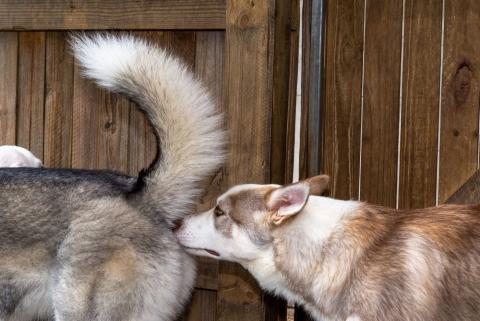
The Curious Case of Dog Butt-Sniffing: What It Really Means
Published on November 15 by Julia
If you’ve ever watched two dogs greet each other, you’ve likely seen them engage in a behavior that may seem odd or even a bit gross to us: sniffing each other’s rear ends. It’s one of those dog behaviors that can leave us scratching our heads, wondering, “Why do they do that?”
While it might seem strange from a human perspective, butt-sniffing is actually a completely natural and essential behavior in the canine world. It’s how dogs communicate with one another and learn important information about each other. Here’s a closer look at why dogs sniff each other’s butts, what they’re getting out of it, and how this behavior helps dogs navigate their social world.
1. It’s All About Scent and Communication
Dogs have an incredibly advanced sense of smell—estimated to be between 10,000 to 100,000 times more powerful than humans. For dogs, scent is their primary way of gathering information about the world around them. Unlike humans, who rely heavily on visual cues and spoken language to communicate, dogs use scent to understand everything from their environment to the emotions and health of other animals.
When dogs sniff each other’s behinds, they’re gathering detailed information about the other dog’s identity. This includes:
- Sex and Reproductive Status: One of the most important pieces of information dogs get from sniffing each other’s butts is the sex of the other dog and whether it’s in heat. Dogs have special scent glands in their anal area called anal sacs that release unique scents. These glands contain chemicals that tell a dog about the other dog’s sex, age, health, and even their emotional state.
- Health and Diet: A dog’s diet, health, and even stress levels can affect the scent produced by their anal glands. By sniffing another dog’s rear end, they can learn if the dog is healthy, if it’s been eating well, or if it’s under any kind of stress or illness.
- Identity and Social Status: Just like a human might ask someone, “Who are you?” or “Where are you from?” dogs use scent to identify each other. Each dog’s scent is unique, and anal glands produce a signature odor that helps dogs recognize familiar dogs or distinguish between strangers. This is particularly important in situations where dogs meet for the first time.
2. Why Butt-Sniffing Is a Dog’s Version of a Handshake
In the human world, handshakes are a common greeting or a way to get to know someone. For dogs, butt-sniffing is their equivalent of a handshake—it’s a way of saying, “Hello,” and gathering crucial information about each other. By sniffing each other’s rear ends, dogs can assess whether the other dog is friendly, nervous, dominant, or submissive. It’s a non-threatening way for dogs to size each other up.
Because dogs don’t have the same complex social cues as humans, their behavior is often more direct and instinctual. Sniffing is simply their way of “checking in” and determining how they should behave. Should they play? Should they be cautious? Should they be wary or friendly? The scent of another dog answers these questions.

3. The Role of Pheromones in Butt-Sniffing
The primary source of the scent that dogs are so interested in comes from pheromones—chemicals that carry information between animals of the same species. In the case of butt-sniffing, these pheromones are released by the anal glands located near the anus. These glands secrete both liquid and solid substances that contain information about the dog’s identity, health, and emotional state.
When dogs meet, they instinctively go for the anal region because it’s rich in these pheromones. Dogs have specialized olfactory receptors in their noses that are highly sensitive to these chemical signals. In fact, there’s a part of a dog’s brain specifically dedicated to processing smells, called the olfactory bulb. This part of their brain is so large compared to humans that dogs are more capable of detecting and interpreting these scents than we could ever imagine.
Pheromones from anal glands can tell a dog a lot of things, including:
- The other dog’s age and gender
- Whether the other dog is in heat (ready to mate)
- The dog’s social status in its pack
- The other dog’s mood (fearful, excited, calm, etc.)
For dogs, pheromones are an incredibly important form of social communication.
4. When Butt-Sniffing Happens: Social Interactions and Pack Behavior
Butt-sniffing isn’t just about casual greetings between dogs; it’s also part of more complex social behavior. In wild dog packs or in multi-dog households, this behavior can be a way for dogs to reinforce social bonds and establish their place in the group hierarchy. By sniffing each other’s butts, dogs learn about each other’s rank within the social structure, helping to maintain order and harmony in the pack.
- Submissive dogs might sniff the rear of a more dominant dog as a way of showing respect.
- Dominant dogs may insist on sniffing the rear of lower-ranking dogs as a way of asserting their authority.
In a household with several dogs, you may notice that more dominant dogs often get to sniff first, while more submissive dogs may wait their turn. This kind of social interaction is a normal part of canine group dynamics.
5. Is Butt-Sniffing Ever Problematic?
For most dogs, butt-sniffing is a perfectly normal and healthy behavior. However, there are times when it can be problematic, especially if a dog is excessively sniffing or showing signs of aggression. Here are a few situations where you might need to step in:

- Aggression or Intimidation: If a dog’s sniffing is causing anxiety or aggression in another dog, it could be a sign that the greeting ritual has become uncomfortable. Some dogs might feel threatened by intense sniffing, especially if they’re not used to other dogs or if they have had past negative experiences with other dogs.
- Health Issues: If a dog is excessively sniffing another dog’s rear end and acting obsessively, it could be a sign that something is wrong. Dogs may be more interested in sniffing if the other dog has an infection, such as a yeast infection in the anal glands, or if there’s something unusual going on with their scent. If the sniffing behavior is accompanied by signs of irritation or discomfort (like licking, biting, or scooting), it could indicate an underlying health issue that requires a vet’s attention.
6. How to Handle Butt-Sniffing Behavior
As long as both dogs are comfortable, butt-sniffing is a natural and healthy part of canine behavior. Here’s how you can manage this behavior:
- Supervision: When meeting new dogs, keep an eye on the interaction to ensure that neither dog feels overwhelmed or threatened. If one dog is overly aggressive with the sniffing, gently redirect them with a firm “no” or by leading them away.
- Positive Reinforcement: Reward good behavior, like calm greetings, with praise or treats. This will encourage dogs to engage in appropriate social behaviors.
- Training and Socialization: Socializing your dog from an early age can help them feel more comfortable with butt-sniffing. If a dog is particularly anxious about meeting new dogs, gradual exposure and positive reinforcement can help them become more confident in social situations.
Conclusion: A Normal Part of Dog Behavior
While butt-sniffing might seem strange to us, it’s actually a completely natural and necessary behavior in the canine world. It’s how dogs gather information about one another, establish social bonds, and navigate their social hierarchies. So, the next time your dog meets a new friend and engages in a little sniffing, remember—it’s their way of saying, “Let’s get to know each other better!”